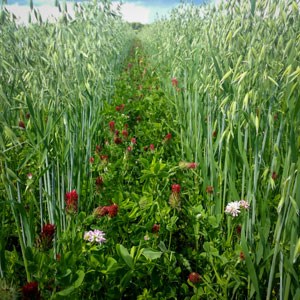Contact
maria.viketoft@slu.se, 018 -67 1505
hanna.friberg@slu.se, 018-671876, 0703-931106
Ola.Lundin@slu.se, 018-673402

Intercropping of cereals with legumes such as clovers hold great potential to create more biodiversity and ecosystem services in agricultural fields. The undersown plant mixtures can be tailored to support more natural pest control, but already now, the benefits are striking without any disadvantages.
To produce food in a sustainable way, we must conserve biodiversity and facilitate ecosystem services in agriculture. One way to increase the diversity in the field is to intercrop with legumes. However, we do not know how helpful this method is for pollination and natural pest control.
Researchers from SLU studied this in the field by undersowing oats with a mixture of three annual clovers.
– We investigated several below-and above-ground ecosystem service indicators related to soil mineral nitrogen, arable weed control, pollination, disease and pest pressures, natural pest control and crop yield, says Hanna Friberg.
Undersowing the oats with clover resulted in less weeds, more flowers and therefore more pollinators.
– There was also a decrease of nematodes that feed on roots in the undersown plots. However, there were less spider activity and the nitrogen content in the oats was somewhat lower than in the control plots. Root diseases, pest damages, natural pest control and crop yield were not affected, says Maria Viketoft.
This study demonstrates that undersowing annual clovers suppresses weeds and supports pollinators, without reducing crop yields or taking land out of arable production.
– Our intercropping system still holds potential for improvement to achieve higher levels of cropping system multi-functionality, but it shows clear improvements compared with single crop cultivation, says Ola Lundin.
– The undersown plant mixtures can be tailored to support a wider spectrum of pollinators and benefit natural pest control to get even more advantages in the cropping system, concludes Fabian Boetzl.
maria.viketoft@slu.se, 018 -67 1505
hanna.friberg@slu.se, 018-671876, 0703-931106
Ola.Lundin@slu.se, 018-673402
Read the full story “Undersowing oats with clovers supports pollinators and suppresses arable weeds without reducing yields” in Journal of Applied Ecology.